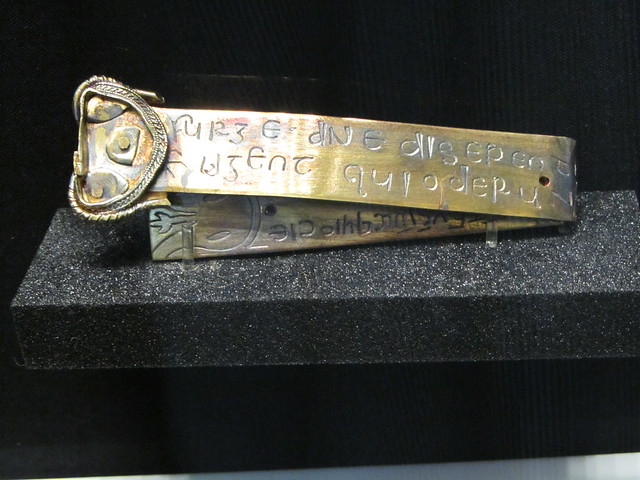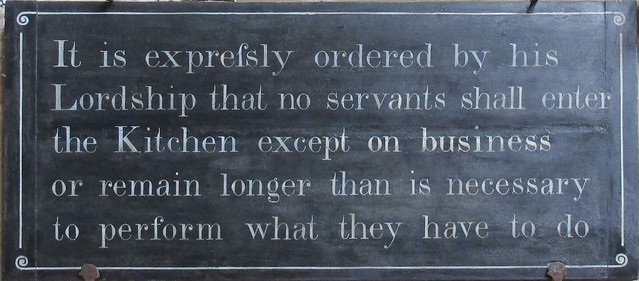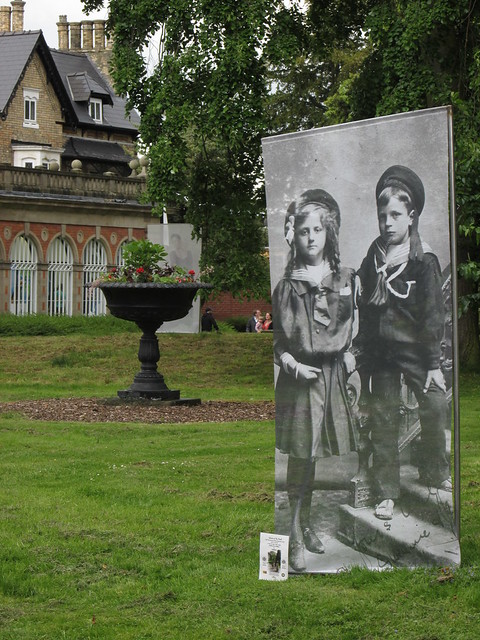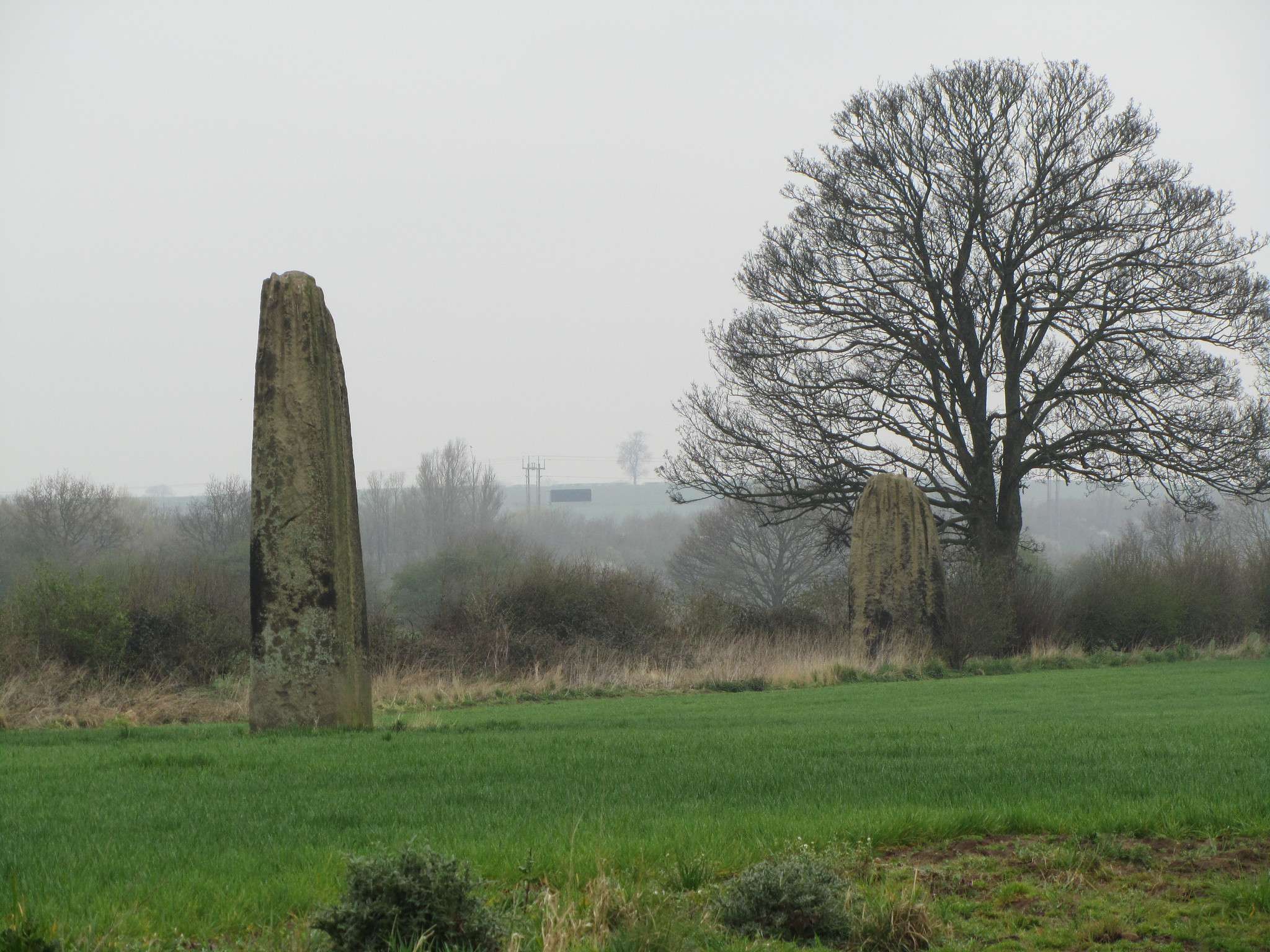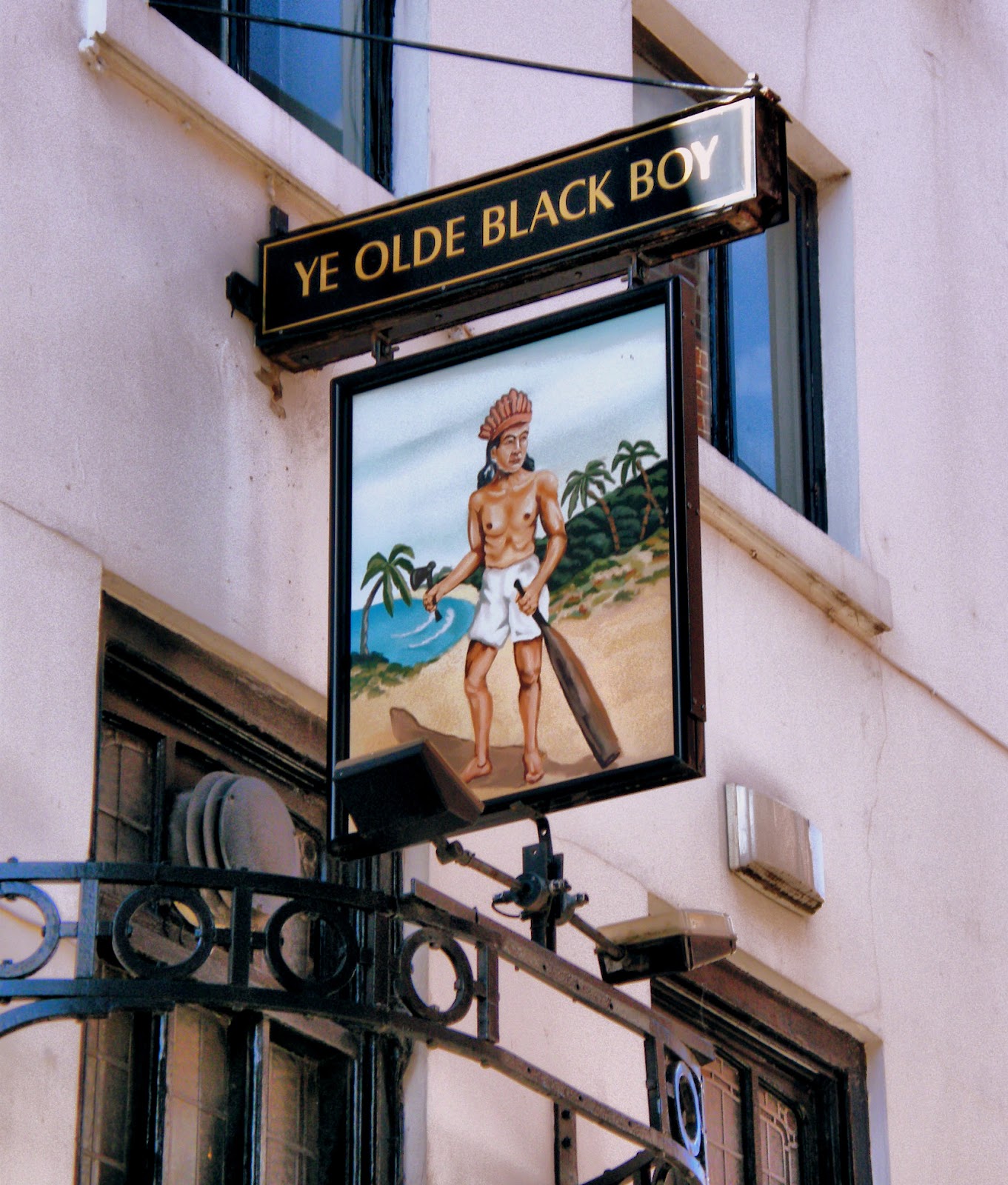One of these flew past our house at the weekend. This particular plane is owned by the Vulcan to the Sky Trust, a charity who maintain and fly her as a monument to history. Sadly, this year is probably going to be her last in the air and she's taking part in farewell flights around the country.
Not so long ago the distinctive delta form planes were a common sight over the UK. The bomber was operated by the Royal Air Force from 1956 until 1984. They were part of the cold war force that protected Britain against perceived enemies in the east.
The Avro Vulcan was designed at the height of UK aerospace engineering. Its shape influenced the creation of Concorde and the Space Shuttle. It is a big plane in every way. It has a wingspan of 30 metres and is 30 metres long. It's powered by Rolls-Royce jet engines.
Back in the days when I lived in Lincoln, just off the end of the runway at RAF Waddington, I grew accustomed to the roar as the flights of four took off at all hours. They were loud, and for their size they were remarkably graceful. It's a tragedy that soon there won't even be one left flying.
Saturday, 27 June 2015
Monday, 22 June 2015
Staffordshire hoard
Much is still to be discovered about the Staffordshire
Hoard. It is generally acknowledged to be the largest-ever find
of Anglo-Saxon gold items. In excess of 3,400 objects and fragments were discovered by a metal detectorist in 2009 in a field near Lichfield. Together they weighed more than 6kg, mainly gold, but some silver.
There is no doubt from the style of the pieces that they are from the Anglo Saxon period, but an exact date has yet to be agreed for them. Archaeologists are trying to determine what is known as a 'terminus post quem' (limit after which). The argument goes that the stash must have been buried at some point after the date of the newest item.
For example, if you look at a handful of coins from your pocket you might find them dated 2000, 2015, 2014, 2012, 2009, 2008. (I just did that to have accurate dates.) You know from this that today's date must be at least 2015, because the 2015 coin wouldn't have existed any earlier. This is a TPQ. (Of course, you can find out today's date in much easier ways, but you get the idea.)
A great deal of the specimens are items connected with warfare and fighting. For example there are pieces of armour, including a high status helmet. Other examples include a hilt plate from a single-edged knife (called a seax). And there are more than 70 sword pommels (the bit at the end of the grip) including one whose design is unique to this collection.
Much of the hoard is richly decorated in several ways. There are examples of millefiori glass, very many instances of chasing to form intricately interlinked animals, and inlaid semi-precious stones such as garnets. Other items are decorated with filigree (fine twisted wire) designs, in particular the 'seahorse' piece. It has been estimated that many of the items belonged to a person or persons of high status.
The top photo shows a replica of an inscribed strip. It is believed that it was part of a cross that might have been mounted on the cover of a prayer book or gospel. The inscription is from the Bible and is in Vulgate Latin. "Rise up, O Lord, and may thy enemies be dispersed and those who hate thee be driven from thy face." Other items in the collection show clear evidence of pagan symbolism. A few show both pagan and christian symbols together.Clearly it was a time of change.
And why is the photo of a replica? Because it appears at any time that originals are on display you are discouraged from photographing them. (This is why the remaining photos are from the hoard's official website.) Part of the stash is on display at the Potteries Museum and Art Gallery in Stoke on Trent, part in Birmingham Museum and Art Gallery, some pieces at Tamworth Castle, and there is even a selection in a touring exhibition that is currently in Burton on Trent.
The inscription photo was taken at the exhibition in Lichfield Cathedral some time ago. I'm not sure what difference it makes that only replicas were on show (of anything significant anyway) but Cathedral bosses allowed cameras into the display. Thank you, Lichfield Cathedral.
There is no doubt from the style of the pieces that they are from the Anglo Saxon period, but an exact date has yet to be agreed for them. Archaeologists are trying to determine what is known as a 'terminus post quem' (limit after which). The argument goes that the stash must have been buried at some point after the date of the newest item.
| Pic from: staffordshirehoard.org.uk |
A great deal of the specimens are items connected with warfare and fighting. For example there are pieces of armour, including a high status helmet. Other examples include a hilt plate from a single-edged knife (called a seax). And there are more than 70 sword pommels (the bit at the end of the grip) including one whose design is unique to this collection.
| Pic from: staffordshirehoard.org.uk |
The top photo shows a replica of an inscribed strip. It is believed that it was part of a cross that might have been mounted on the cover of a prayer book or gospel. The inscription is from the Bible and is in Vulgate Latin. "Rise up, O Lord, and may thy enemies be dispersed and those who hate thee be driven from thy face." Other items in the collection show clear evidence of pagan symbolism. A few show both pagan and christian symbols together.Clearly it was a time of change.
And why is the photo of a replica? Because it appears at any time that originals are on display you are discouraged from photographing them. (This is why the remaining photos are from the hoard's official website.) Part of the stash is on display at the Potteries Museum and Art Gallery in Stoke on Trent, part in Birmingham Museum and Art Gallery, some pieces at Tamworth Castle, and there is even a selection in a touring exhibition that is currently in Burton on Trent.
The inscription photo was taken at the exhibition in Lichfield Cathedral some time ago. I'm not sure what difference it makes that only replicas were on show (of anything significant anyway) but Cathedral bosses allowed cameras into the display. Thank you, Lichfield Cathedral.
Friday, 19 June 2015
I know my place
And if I hadn't known it, I'd have soon learned if I worked at Burghley House in Lincolnshire. This sign is prominently displayed on the chimney front in the kitchen.It makes you wonder what some staff had done in the past to make 'his Lordship' feel the need to erect such a notice.
A couple of points of interest in the English. It's to be expected that Lordship should have a capital letter, but why Kitchen? Clearly this was viewed as an important room. (Germany still uses capitals on nouns, but other words don't have them here, so that's not the influence.) It's also old enough to have the 'f' in place of an 's' in 'exprefsly'.
The kitchen at Burghley is a fascinating place with fine examples of 18th and 19th century cookware displayed along its Tudor shelves. There is also a magnificent cast iron roasting range, dated 1840, and made by a London company. It was powered with charcoal and provided heat to a back boiler as well as cooking. It incorporates an elaborate spit mechanism for turning huge joints of meat as they cooked.
A couple of points of interest in the English. It's to be expected that Lordship should have a capital letter, but why Kitchen? Clearly this was viewed as an important room. (Germany still uses capitals on nouns, but other words don't have them here, so that's not the influence.) It's also old enough to have the 'f' in place of an 's' in 'exprefsly'.
The kitchen at Burghley is a fascinating place with fine examples of 18th and 19th century cookware displayed along its Tudor shelves. There is also a magnificent cast iron roasting range, dated 1840, and made by a London company. It was powered with charcoal and provided heat to a back boiler as well as cooking. It incorporates an elaborate spit mechanism for turning huge joints of meat as they cooked.
Wednesday, 17 June 2015
The history of the scarecrow
| Image from the Daily Telegraph |
Why do we have scarecrows?
Farmers have always had a problem with birds eating their crops. Long ago, if there was no corn or wheat to make bread, families would have no staple food. So, for more than 3,000 years, farmers have been making scarecrows to frighten off the birds from their fields.
In Egypt records show that farmers by the Nile river enticed quail birds into big nets which were set on poles; then they took their catch home and cooked them for dinner!
About 2,500 years ago the Greeks were modelling their scarecrows on a man who was said to be so ugly that, when he was by the fields, he scared the birds away. The Romans copied the Greeks and made similar carved scarecrows.
As the Romans conquered lands, including England, they introduced this idea of a human-like scarecrow. It became a widespread practice, even as far as Japan. The Japanese originally scared birds away from their rice fields with bad-smelling poles called kakashis. These gradually took on a more human form. In Germany they made them look like witches.
Over the centuries each country was developing its own style. In Medieval Britain the task was done by boys of nine or older. They patrolled the fields with bags of stones to throw at the birds and chase them off. They were called bird scarers or bird shooers!
In 1348 Britain's population halved because of the Great Plague, so bird scarers were in very short supply. Farmers turned to stuffing sacks with straw, carving faces out of turnips and standingthese mede-up bird scarers on poles in their fields. Boys and girls continued to patrol the fields but now they used wooden clapp0ers whose noise scared off whole flocks of birds.
In North America the native American tribes also used human bird scarers, usually adults. In the southwest the Zuni tribe held contests to see who could make the most unusual scarecrow.When people from Europe emigrated to America they took their ideas with them, such as making a bogeyman and bogeywife to keep guard at each end of a field!
Scarecrows are still used all over the world; spraying crops with chemicals was found to be harmful to humans and the noise created by automatic crop protectors was harmful to their ears! In the east stones are still thrown to scare away the birds. In the growing season scarecrows can still be seen in fields, allotments and gardens and many farming communities, like the Zuni tribe in America, hold scarecrow contests.
As long as birds are hungry and farmers are growing crops to feed the people, they will look for ways to ... scare crows!
*****
There's no clue on the leaflet about who wrote the words. If it's you, just contact The Anorak and I'll be happy to credit you.Monday, 15 June 2015
Bringing history to life
Derby Arboretum is celebrating 175 years this year. It's the oldest public park in Britain and was the inspiration for New York's Central Park. As part of the celebrations photographer Howie Johnson has staged an exhibition of pictures that show off the park in a different way.
He has merged old photographs with modern shots, in a series he has called Ghosts of the Park. And he has created life-sized images on mesh, which are on show throughout June among the trees, as if the ghosts have come to life. Some of the ghosts are from original pictures of the park, but some are photographs he has created using modern models in Victorian costume.
For one day only, people were invited to dress in Victorian costume and take a picnic to the park, to see the ghosts and be part of its ongoing history. There was a good turnout, and people of all ages and races joined in. Derby is a multi-cultural city and the history of some ethnic groups in the town is as long as the park's.
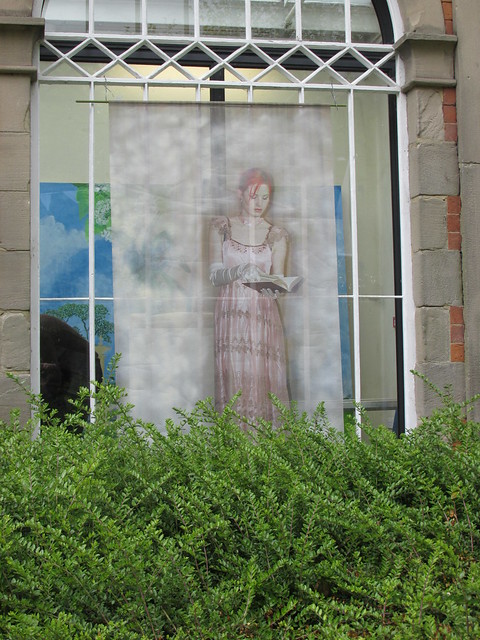 The arboretum was the brainchild of industrialist Joseph Strutt. The silk merchant and cotton mill owner gave the land to the town in 1840 because he was concerned about the lack of fresh air for residents of the increasingly industrialised area. Ironically, pollution levels killed many of the 1,000-plus species that were planted in the park.
The arboretum was the brainchild of industrialist Joseph Strutt. The silk merchant and cotton mill owner gave the land to the town in 1840 because he was concerned about the lack of fresh air for residents of the increasingly industrialised area. Ironically, pollution levels killed many of the 1,000-plus species that were planted in the park.
Strutt wanted the arboretum to be both a place for exercise and recreation, and educational. His instructions were that no species was to be repeated across the 11 acres, to encourage people to walk all the way around it.
The layout was designed by Joseph Claudus Loudon, a 19th century horticulturalist who had strong views on social responsibility. He felt rich factory owners of his time had a duty to look after their workers, and had already expressed a desire to create a public park.
The current exhibition clearly attracted a lot of attention and local people were engaged with it. Wandering around the park, seeing the translucent figures of Derby residents past and present walking alongside, was a great way to consider the park in a new light. Many of the visitors to the picnic event had never been to the park before.
It's likely that the majority of Derby residents don't even know the park exists (it's not central) let alone its historical significance. It's to be hoped that this exhibition goes a long way towards letting the town know what it has and how much it should value it.
By the end of the 20th century vandalism and neglect (and WWII bombing) had taken their toll on the arboretum and it was very much the worse for wear. However, a Heritage Lottery Fund grant enabled the city council to make an investment in it. Much of the park was restored, including a replica of the Florentine Boar (see photo above). According to an information panel in the park, Strutt commissioned sculptor W J Coffee to make a ceramic replica of a boar statue to be found in Florence, Italy.
Strutt originally had the work at his own home, but donated it to the park for the official opening. The boar survived until a bombing raid in 1941 caused severe damage, then it was taken away. The current boar is a bronze replica, of the replica!
| One of Howie's merged photos |
For one day only, people were invited to dress in Victorian costume and take a picnic to the park, to see the ghosts and be part of its ongoing history. There was a good turnout, and people of all ages and races joined in. Derby is a multi-cultural city and the history of some ethnic groups in the town is as long as the park's.
 The arboretum was the brainchild of industrialist Joseph Strutt. The silk merchant and cotton mill owner gave the land to the town in 1840 because he was concerned about the lack of fresh air for residents of the increasingly industrialised area. Ironically, pollution levels killed many of the 1,000-plus species that were planted in the park.
The arboretum was the brainchild of industrialist Joseph Strutt. The silk merchant and cotton mill owner gave the land to the town in 1840 because he was concerned about the lack of fresh air for residents of the increasingly industrialised area. Ironically, pollution levels killed many of the 1,000-plus species that were planted in the park.Strutt wanted the arboretum to be both a place for exercise and recreation, and educational. His instructions were that no species was to be repeated across the 11 acres, to encourage people to walk all the way around it.
The layout was designed by Joseph Claudus Loudon, a 19th century horticulturalist who had strong views on social responsibility. He felt rich factory owners of his time had a duty to look after their workers, and had already expressed a desire to create a public park.
The current exhibition clearly attracted a lot of attention and local people were engaged with it. Wandering around the park, seeing the translucent figures of Derby residents past and present walking alongside, was a great way to consider the park in a new light. Many of the visitors to the picnic event had never been to the park before.
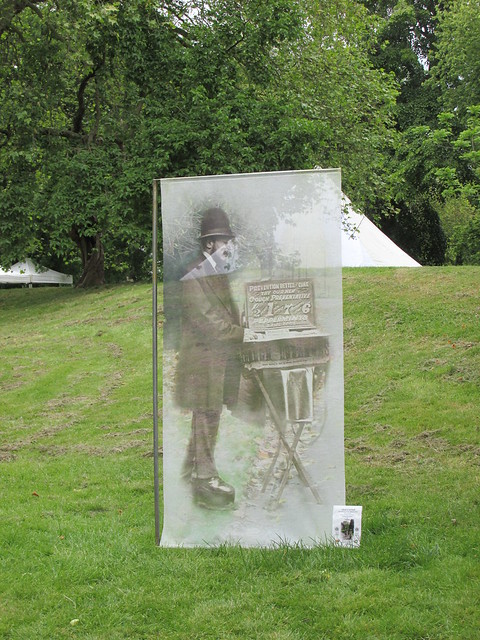 |
| He's offering peppermint cough preventative! |
By the end of the 20th century vandalism and neglect (and WWII bombing) had taken their toll on the arboretum and it was very much the worse for wear. However, a Heritage Lottery Fund grant enabled the city council to make an investment in it. Much of the park was restored, including a replica of the Florentine Boar (see photo above). According to an information panel in the park, Strutt commissioned sculptor W J Coffee to make a ceramic replica of a boar statue to be found in Florence, Italy.
Strutt originally had the work at his own home, but donated it to the park for the official opening. The boar survived until a bombing raid in 1941 caused severe damage, then it was taken away. The current boar is a bronze replica, of the replica!
Saturday, 13 June 2015
Who threw those stones?
They are called the Devil's Arrows and there are three of them. No-one is quite sure how many there were originally, or even what shape they were laid out in. Were they supposed to be part of a huge henge circle, or an alignment?
They are in Boroughbridge, North Yorkshire, and easy to find on the edge of town. They are quite large, coming in at 18, 22 and 22 and a half feet tall. (5.5 and around 7 metres) That last one, according to the town's website, is taller than anything you'll find at Stonehenge.
There's a lovely tale associated with them. Apparently Old Nick (you know, the fallen angel) fell out with the neighbouring manor of Aldborough for some reason and decided to hurl huge stones at the residents as a punishment. He stood on How Hill, near Fountains Abbey, to get a better reach, but his throw wasn't up to it and the stones fell short.
Current archaeological thinking is that they were probably a single row. According to 16th century reports there were once at least four stones 'set in a straight and direct line'. (William Camden, 1560). The fourth stone is believed to have been incorporated into a bridge in the grounds of Aldborough Manor.
For more information see the Boroughbridge website.
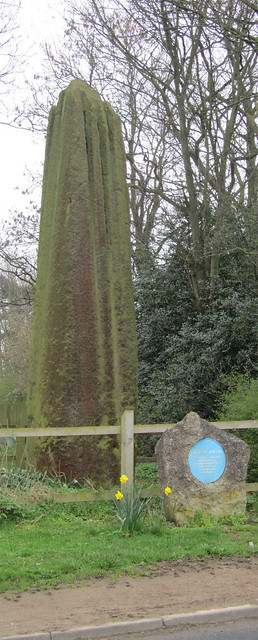 |
| The third stone |
There's a lovely tale associated with them. Apparently Old Nick (you know, the fallen angel) fell out with the neighbouring manor of Aldborough for some reason and decided to hurl huge stones at the residents as a punishment. He stood on How Hill, near Fountains Abbey, to get a better reach, but his throw wasn't up to it and the stones fell short.
Current archaeological thinking is that they were probably a single row. According to 16th century reports there were once at least four stones 'set in a straight and direct line'. (William Camden, 1560). The fourth stone is believed to have been incorporated into a bridge in the grounds of Aldborough Manor.
For more information see the Boroughbridge website.
Friday, 12 June 2015
A small historic moment
I have my first follower! Welcome to Katharine at Art-e-facts: encounters with objects in museums.
I'm honoured. She runs an excellent and informative blog. Go visit her here.
I'm honoured. She runs an excellent and informative blog. Go visit her here.
Tuesday, 9 June 2015
Politically (in)correct?
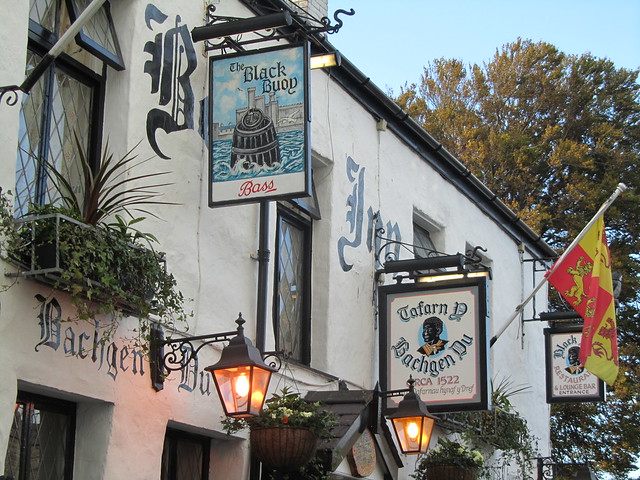 |
| Black B(u)oy Inn, Caernarfon |
Then again there is the tale of Jack Black, as told on the Inn's website. Jack Black was a young man of colour who was taken prisoner in Africa in the 1750s and brought to London.* He was then moved on to Ystumllyn, a mansion house in Porthmadog, where he was employed as a gardener. He was a handsome man, and popular with the ladies, and eventually ran away to marry a girl in Criccieth, whereupon he lost his employment at Ystumllyn. However, he and his wife found positions in Dolgellau, among other places. John became a celebrity across North Wales, on account of his colour, and therefore it is possible that the Inn was named in his honour. He died of jaundice in 1786 at the believed age of 46. (For more on Jack Black click here)
The Black Boy Inn name does not date back as far as the building. The pub is believed to date from 1522 and is one of the oldest inns in North Wales, and the street it stands in is recorded as 'Black Boy Street' (in Welsh!) on documents from the 1794 census. Although the street was also known as Stryd Pedwar a Chwech, which literally translates as 'street four and six' - 4/6 (four shillings and sixpence) being the price of a good room and a whore!
There are lots of other Black Boy inns and pubs around the UK, all dating from less politically correct times. For example: Heage in Derbyshire, Winchester in Hampshire, Hull in East Yorkshire, Banbury in Oxfordshire, Knowle in Warwickshire, Shinfield in Berkshire, Hungarton in Leicestershire, the list is really very long. Most claim to commemorate Charles II, even if their inn signs show a very different (and less polite) version of the name.
(Retford. Photo from Geograph)
(Hull. Photo from Hull and Hereabouts blog)
(Bushey, Herts. Pubsandbeer.co.uk)
But I do like this one from Bury St Edmunds:
(Another Geograph photo)
* Slavery wasn't abolished in the UK until 1833.
Saturday, 6 June 2015
Ley lines
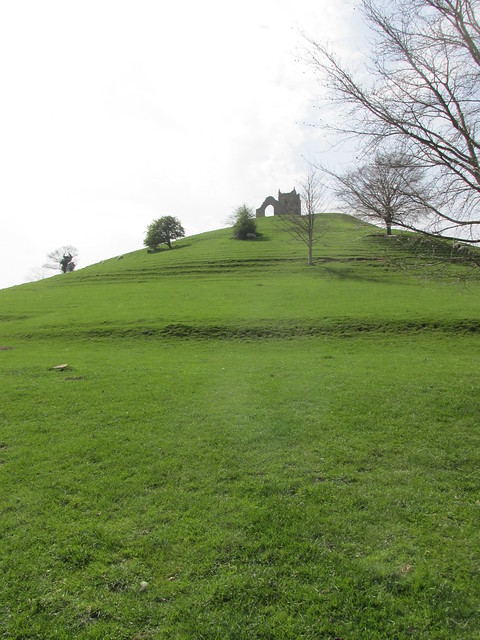 |
| Burrow Mump |
It goes without saying that many of the points on these routes - known as ley lines - are stone circle sites or other ancient monuments. Naturally Avebury is one such point, so it was no surprise to find a map there. But what came as a surprise was the fact that several places we had visited that week were marked as significant.
The so-called St Michael's ley line runs from Land's End in Cornwall to a point on the Norfolk coast. It passes through Avebury, as well as Taunton and Glastonbury. It also passes through a place called Burrow Mump, close to the site of the Battle of Sedgmoor. We found the Mump during our travels. You can't really miss it. It's a huge spot on an otherwise flat landscape. And there are the remains of a church on top of it.
Like many other churches along the line, it was dedicated to St Michael. We had no idea when we discovered the Mump that it had any supposed mystical status. I just liked the idea that there was a huge bump in the middle of nowhere with a wreck on top - so we climbed up to take a look at the tumbledown church, and the view from the top. Both were impressive.
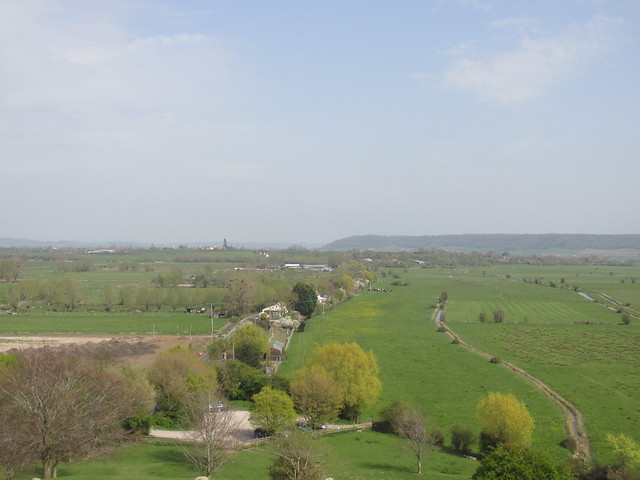 |
| The view from the top |
The hill and ruin have been owned by the National Trust since 1946, when they were donated, with the proviso that the building should serve as a memorial to the 11,281 Somerset men and women who died in two world wars. It is now a scheduled ancient monument.
So is there any truth in the idea of ley lines? It's theoretically possible to draw a line across any part of the UK and link up villages that are situated more-or-less on top of it. Particularly if you take liberties with the map - like this one.
| Photo from Discussion World Forum |
Thursday, 4 June 2015
Spiting your neighbour
Nowadays there are planning rules to control how people extend their homes, but not so long ago owners could do what they liked. And in Silverdale*, Lancashire, several built what's known as 'spite walls' just to get one over on their neighbours.
There are examples all around the village, but one of the best known is in Stankelt Road. (This link will open Google Streetview.) Apparently the house on the left had a clear view over open countryside until owner Right decided to put his house smack next to the boundary. So Left built the huge wall, cutting out light and getting his own back on Right.
Other walls exist throughout the area. It's a coastal village and some were erected simply to prevent next door having a sea view! The people of Silverdale appear quite friendly these days so it's not clear why they were so aggressive in the past. Neither is it clear why nobody knocks the walls down these days.
Some have been lowered, as a gesture of goodwill. The book Cheek by Jowl: A History of Neighbours, by Emily Cockayne gives details of one in Shepton Mallet (Somerset) that's protected by Grade II listing.
*Silverdale is on the west coast, on Morecambe Bay, just north of Lancaster and VERY close to the Cumbrian border.
There are examples all around the village, but one of the best known is in Stankelt Road. (This link will open Google Streetview.) Apparently the house on the left had a clear view over open countryside until owner Right decided to put his house smack next to the boundary. So Left built the huge wall, cutting out light and getting his own back on Right.
Other walls exist throughout the area. It's a coastal village and some were erected simply to prevent next door having a sea view! The people of Silverdale appear quite friendly these days so it's not clear why they were so aggressive in the past. Neither is it clear why nobody knocks the walls down these days.
Some have been lowered, as a gesture of goodwill. The book Cheek by Jowl: A History of Neighbours, by Emily Cockayne gives details of one in Shepton Mallet (Somerset) that's protected by Grade II listing.
*Silverdale is on the west coast, on Morecambe Bay, just north of Lancaster and VERY close to the Cumbrian border.
Wednesday, 3 June 2015
Location Location Location
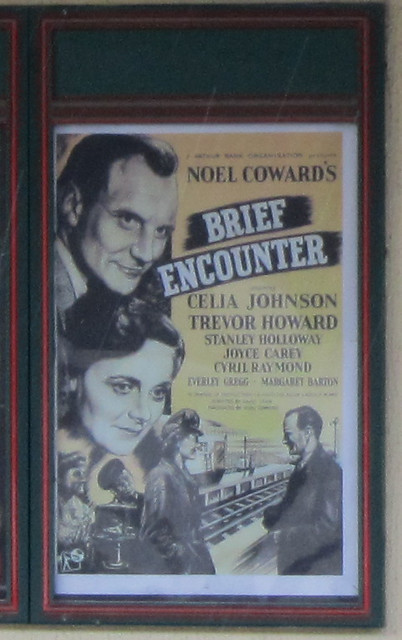 |
| I love you. I love you. You love me too. It's no use pretending it hasn't happened because it has. |
Carnforth Station is actually quite famous in its own way. It was the "star" of the 1945 David Lean romantic film of the Noel Coward play Brief Encounter. If you're of a certain age you know exactly which film I mean. Trevor Howard and Celia Johnson getting themselves into a middle class pickle over a little sexual attraction. Lots of stiff upper lips and clipped English vowels.
So my question is this: does being the location for a film (albeit a well-known one) justify the fact that this little out of the way place has a "heritage centre"? It also has a Brief Encounter Refreshment Room. If you've seen the film you'll know why.
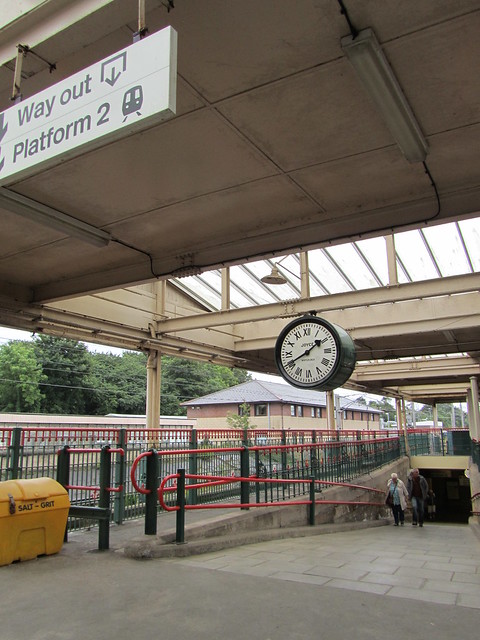 |
| That clock |
The film was shot in wartime and had to be made outside timetable hours so it didn't interfere with troop movements. The location was chosen because of its isolation. The powers-that-be in the War Office felt it was unlikely to be a target for German bombers so the film crew and stars would be safe there.
All this can be found out at the Carnforth Station Heritage Centre, as well as quite a bit about the role the station played in shifting troops around the country throughout the war. Now that is history. However, does the film location count as well? I admit I'm a fan. I've loved Brief Encounter for years, and I did spend time sitting in the waiting room watching a hefty chunk of the film, which plays on a loop during opening hours. But is it really heritage? What do you think?
Some other well-known locations
Castle Howard, North Yorkshire - Brideshead Revisited (1981 Granada TV)
The Historic Dockyard, Chatham, Kent - Call the Midwife (2012-present BBC)
Gloucester Cathedral (and lots of other places) - Harry Potter series (2001-2011 Warner Brothers)
Venice - Don't Look Now (1973 British Lion)
Vienna - The Third Man (1949 London Film Productions)
Subscribe to:
Comments (Atom)

